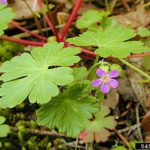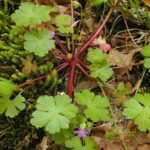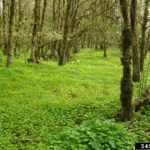Gallery:
- Shining geranium leaves and flowers
- Shining geranium red stems
- Shining geranium infestation
Common names:
Shining geranium, shiny geranium, shiny leaf geranium, shining crane’s bill
Scientific Name:
Geranium lucidum
Description:
Shining geranium is an annual herbaceous plant in the Geraniaceae (geranium) family. It can spread rapidly and quickly cover the ground of oak woodlands and forest openings. The pink flowers grow in pairs and have 5 separate petals with longitudinal ridges. The leaves are sparsely hairy and shiny, with 5 – 7 lobes that are again lobed. The stems have a reddish tint and grow from a weak central root. It spreads by seeds, which are forcefully ejected, and are small, abundant, and easily spread by boots, vehicles, and animals.
Life cycle:
Height of mature plants
Up to 19 inches
Flower color:
pink
Bloom time:
April to July
Look-a-likes:
Shining geranium looks quite similar to the common weed called dovefoot geranium. Dovefoot geranium’s stem are green and the leaves are not shiny. Shining geranium often grows with Robert’s geranium, which has finely divided leaves and is stinky.
Habitat:
Shining geranium can grow in a variety of light conditions. It grows well as an understory species in oak woodlands, forest openings and edges, well-shaded woodlands, grasslands, and roadsides.
Impacts:
Shining geranium emerges earlier than most native plants, and can quickly dominate the ground, preventing native plants from establishing. It can also produce multiple generations in a year, which makes control extremely difficult; after it is killed or removed, another generation of plants will quickly grow back to replace it.
Noxious Weed Listing:
- WeedWise: maintenance
- State of Oregon: Class B
- State of Washington: Class B
- Four County CWMA: Class B
- Columbia Gorge CWMA: Class A
Origin:
North Africa, Asia, Europe
Links:
Oregon Noxious Weed Profile
Washington Noxious Weed Profile
Invasive.org profile
King County Noxious Weed Profile



